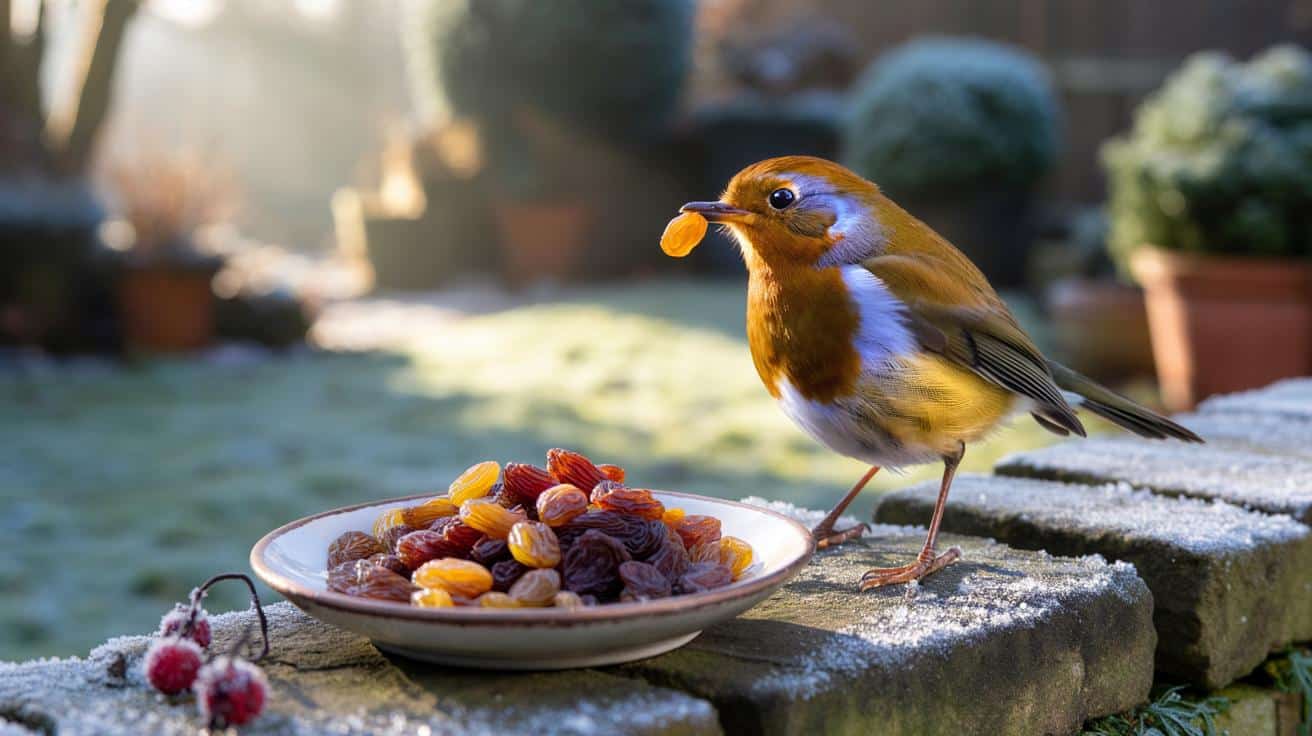A tiny change in your kitchen could help them through the week. It costs less than a bus fare — and you probably have it sitting in the cupboard already.
It starts with that flash of russet at the bird table before the kettle boils. The morning is a bracing slap of air, the lawn rimmed with white, and a robin flicks from fence post to herb pot like it owns the place. You move, it tilts its head, unafraid in the way only a bird that’s seen a thousand breakfasts is unafraid. A saucer goes out. Bread isn’t right, the nuts feel too tough, and the berries on the pyracantha are already pecked to stubs. Then someone mentions raisins. Or sultanas. Warm water, ten minutes, a handful on the low wall. The robin lands with purpose. One peck, two, three. The rest of the garden goes quiet.
Why a 45p cupboard staple is a winter lifeline for robins
The idea is simple: put out **soaked raisins or sultanas**. Not fancy suet blocks or gourmet mealworms — just the **45p kitchen staple** you’d happily scatter into porridge. Robins adore them because they mimic the soft berries and fallen fruit they’d pick through in hedgerows. High in quick energy, easy on a small beak, and ready in minutes. It’s the kind of tiny domestic gesture that feels almost old-fashioned, like warming boots by the radiator, and yet it’s exactly what a robin needs on a freezing morning.
Budget shops sell small bags for roughly 45p to £1, and a few tablespoons go a long way. Soak in warm water for 10–15 minutes, drain, then set them out on a low tray or a flat stone where a robin naturally forages. One reader sent a photo of her robin hopping into a terracotta pot, beak dotted with fruit juice, while her grey cat watched from behind the glass, indignant and utterly ignored. We’ve all had that moment when wildlife acts as if your garden is a tiny stage — and you’re just lucky to have a seat.
There’s logic behind the charm. Dried fruit softens quickly, helping birds conserve precious energy they’d otherwise spend hammering at tough shells. Those sugars are fast-burning fuel against the cold, while trace minerals and fibre keep digestion ticking over. Robins are insect-eaters by design, especially when raising chicks, but winter knocks their menu sideways. Soft fruit fills a gap that mealworms alone don’t cover, and it keeps going when a cold snap silences the soil. *A fistful of fruit can be the difference between shivering and singing.*
How to do it right — and make your robin come back tomorrow
Use a small dish or a low bird table near cover — shrubs, pots, or a climbing rose. Soak a handful of raisins or sultanas in warm water, then pat them dry and offer a tablespoon or two at dawn and again in late afternoon. Rotate the spot every few days and rinse the dish with hot soapy water. If you want to go one better, add a splash of fresh water nearby. Robins notice regularity. Small, steady offerings build trust faster than a once-a-week feast.
Salted leftovers and fatty pan drippings are a no. Raw rice is a myth, bread fills but doesn’t nourish, and anything mouldy can spread disease brutally fast. Robins prefer ground-level snacks, so don’t be surprised if they shun a high feeder. They’re territorial too, so one bird will often claim your dish like a pub regular at their favourite stool. Let’s be honest: nobody does that every day. Do what you can this week, then again on the next cold morning. The rhythm is what counts, not perfection.
Pair that fruit with variety: porridge oats (not instant), a pinch of grated mild cheese, or a few sunflower hearts. Fruit alone is sweet but not complete, and change keeps birds healthy and interested. Winter feeding is a bridge, not a full-time cafeteria, and it works best when gardens feel like safe corners rather than buffets.
“A couple of tablespoons put out at breakfast can see a robin through the hardest hour,” says a veteran city gardener. “You start doing it for them, and it ends up grounding you too.”
- Soak dried fruit for 10–15 minutes.
- Offer small amounts at dawn and late afternoon.
- Place dishes low and near cover, away from hiding cats.
- Rinse dishes often to keep beaks healthy.
- Keep the fruit well away from dogs — raisins are toxic to them.
The science, the stories, and the small cautions
Robins run hot. That plump look is mostly puffed feathers trapping air, and underneath is a furnace. Overnight, their energy drops, so first light is do-or-die for refuelling. Soaked fruit lands fast, no prying needed. Contrast that with tough peanuts on a frosty day — the robin spends calories before gaining any. Think of it like giving a marathon runner a banana instead of a steak six miles from home. The right fuel at the right time changes the whole day.
There’s also the simple matter of access. Not every street has a hedgerow, not every patch keeps fruiting through December. A shallow dish on a back step can mimic that missing hedgerow for the robin that patrols your fence. Elderly neighbours who can’t lift a heavy feeder can still pour warm water over a small handful of sultanas and feel useful. Keep portions small, refresh often, and watch. The first visit might be cautious. The second feels like recognition.
One serious note: **keep them away from dogs**. Raisins and grapes are toxic to canines, even in tiny amounts, with effects that vary unpredictably. If you share space with a dog, feed birds out of reach — a raised table in a fenced border or a hanging tray that drops crumbs into a plant bed instead of onto the patio. No milk for birds, no salted butter or cooking fat mixed with scraps, and no sticky balls rolled in desiccated coconut. If you want a richer option, a few mealworms or a thumb of suet are solid companions to fruit. Your robin will read your menu like a loyal customer and return for the daily special.
What it says about us when we feed a robin
There’s something about a robin at two arm’s lengths that rearranges a morning. It’s not just the colour, it’s the eye contact. This is a bird that looks straight back at you, as if it has a question, perhaps an opinion. Feed one through a cold spell and you’ll notice your sense of time shifting. Days become softer, measured by the scrape of a tiny beak and the brief hush that comes when a wild thing decides your space is safe. Share that feeling. Tell a neighbour. Leave a little dish by the back step and see who arrives. The quiet reward is real.
| Point clé | Détail | Intérêt pour le lecteur |
|---|---|---|
| Soak dried fruit | Raisins or sultanas in warm water for 10–15 minutes, then drain | Makes a soft, high-energy feed that robins can eat quickly |
| Feed low and near cover | Use a shallow dish on a wall, step, or low table beside shrubs | Matches robin behaviour and keeps birds feeling safe |
| Small, regular portions | Tablepoon at dawn and late afternoon; rotate spots; clean dishes | Builds trust, supports health, and reduces disease risk |
FAQ :
- Why raisins and sultanas — aren’t they too sweet?They’re a stand-in for hedgerow fruit, offering quick energy in winter. Pair with oats, mild cheese, or a few sunflower hearts for balance.
- Do I need to soak them every time?Yes. Soaking softens the fruit so robins can eat with minimal effort, which saves energy on cold mornings.
- Where should I put the dish?On a low surface near cover, not in the open centre of the lawn. Robins like to hop out, peck, duck back.
- Is bread okay if I’m out of fruit?Small crumbs won’t kill a bird, but they’re poor nutrition. Better to skip bread and use oats or a little grated mild cheese.
- What about pets and pests?Keep dried fruit well away from dogs and pick a spot that doesn’t invite rats. Clean often and offer small amounts so nothing sits overnight.







